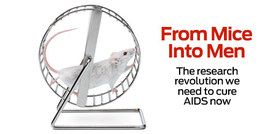
For so many different reasons - past disappointments, scientific knowledge of HIV’s recalcitrant ways; not to mention a conspiracy theory or two - many of us have pretty much abandoned hope that HIV can, in fact, be cured.
I’ve been involved in HIV/AIDS treatment education and advocacy for a lot of years and, like numerous colleagues, have found myself focusing instead on arguably less lofty accomplishments: the development of new antiretrovirals that work a bit better, are somewhat less toxic or easier to take than currently available agents; data further pinpointing the ideal time to begin or switch treatment; and public policy changes that will potentially improve access to care nationally and globally. All important, yes... but hardly the earth-shattering and epidemic-ending stuff we’ve been silently waiting for.
It’s time to begin thinking, talking, writing and advocating about a cure for HIV. There are essentially two reasons for this.
First, we simply can’t afford to sidestep the issue any longer. Whether we’re gauging the situation in the United States or the poorest nations on Earth, the epidemic continues unabated - despite billions of dollars being spent annually to prevent new transmissions and provide care to those living with HIV, millions continue to become infected and die.
One considerable factoid to consider in this context: For every two people we put on treatment in the world, three more become infected with the virus. As a result, it is unlikely we will ever be able to treat our way out of this global catastrophe.
Second, research into the cure is very much under way. Beneath the façade of relatively tedious science speak - terms like latent reservoirs, long-term nonprogressors, therapeutic vaccines and gene therapy, to name just a few - are potential cures for HIV. We’re talking functional cures, whereby HIV is kept in check without the need for chronic antiretroviral therapy, or the biggest, grandest grail of them all: a sterilizing cure, in which every HIV protein is vanquished from the human body
Needless to say, a safe and affordable cure - whether it’s a single agent or, more realistically, a combination of modalities - won’t be on the U.S. Food and Drug Administration’s doorstep anytime soon. However, it’s slowly coming into view on the horizon, albeit still out of focus and without a defining shape. It’s no longer a mirage, but something very real indeed.
It’s going to take more than hopes and dreams to bring these agents to fruition. We’re going to need money and resources - plenty of both - which will only be possible if people living with HIV and the people who represent them begin to sit up, take notice, and start pushing for what has long evaded us.
Please take some time to read "From Mice to Men," written by Regan Hofmann and myself, from the October/November 2010 issue of POZ. Though the article barely begins to scratch the surfaces of the policy and scientific issues surrounding our quest for a cure, the one thing that should be abundantly clear is that it’s high time we all begin pushing for the biggest scientific breakthrough of them all.







3 Comments
3 Comments